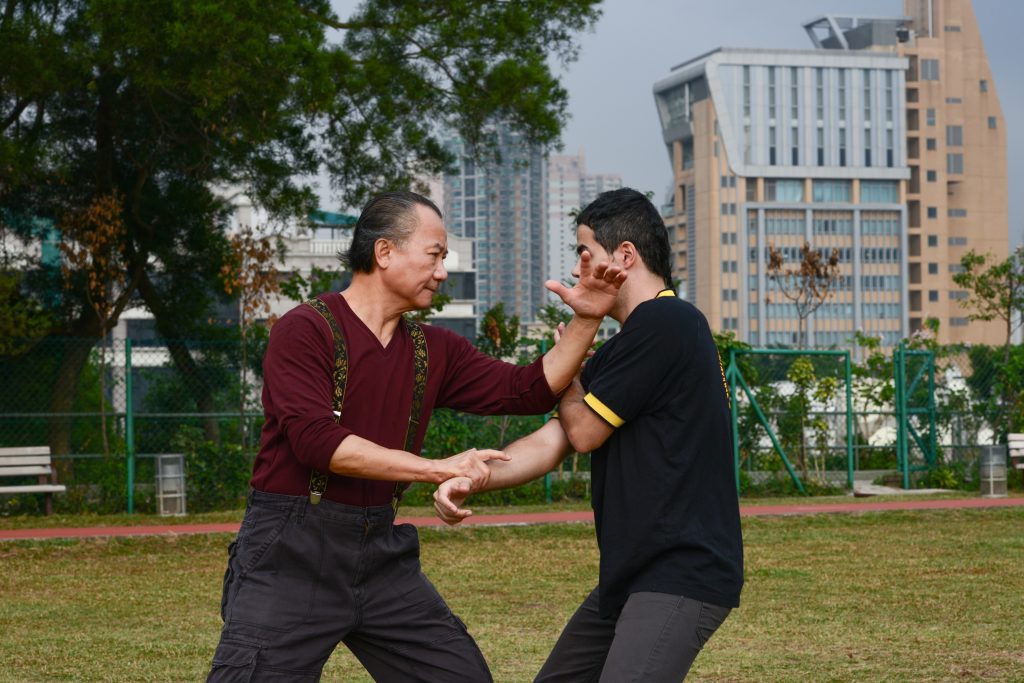Chi Sau is Wing Chun’s most distinguishable exercise. Often, when people think Wing Chun, they think Chi Sau. There can be no doubt that this peculiar exercise is at the heart of our system.
The theory behind Chi Sau is simple. You train yourself to create a bridge with the opponent so that you no longer have to rely on speed or reflexes to avoid his strikes. By sticking to him, your arms can react like antennas that tell you what the opponent is about to do. Almost like a “Spider-sense”. You then use Wing Chun’s unique shapes (Tan Sau, Bong Sau, etc…) to absorb, deflect or simply crash through, depending on the situation.
It’s a great theory, and when put to good use it can be a devastating strategy. You can see it being used amongst elite boxers who immediately clinch after throwing combinations. Sticking to the opponent allows you to shut down their offence. The Wing Chun fighter then uses his greater experience in close-range fighting to dominate. It’s the same thing BJJ guys do. They take the fight to the range they feel most comfortable with.
Having said that, there are a few things to consider. Here are our top 5 ways to improve Chi Sau.
NUMBER 1 – ENTERING
Rather than standing next to each other, lifting your arms and then proceeding to roll, Chi Sau can begin before contact is made. As you approach your sparring partner, you can both make a controlled attempt to enter each other’s defense, after which you can continue rolling.
NUMBER 2 – NO CHEAP SHOTS
Often in Chi Sau, you will see a person straightening their arms and hitting their opponent. All good, right? Isn’t that the point? Well, no.
Chi Sau cultivates the art of hitting and not getting hit. So before you strike your partner, think to yourself: “Can he hit me at the same time?” If the answer is yes, you are only engaging in a tic for tac game which will cultivate little Martial Skill. The idea is to use angles to achieve a win-lose situation. You win, he loses. You can hit him, he cannot hit you.
NUMBER 3 – BENT ELBOWS
This one is related to number 2. Fully straightening your arms creates gaps that can be exploited by your opponent. Grandmaster Wan Kam Leung often talks about maintaining the angle 135 degrees at the elbows. This creates a wedge-like, shield-like structure that provides superior coverage. This makes sense when fighting at close range.
NUMBER 4 – CHASING HANDS
Rolling is great, but the ultimate purpose is to get your opponent’s arms out of the way so you can hit him. That should always be the first priority. Don’t get too used to rolling back and forth for hours, because this is not the ultimate goal. In a controlled fashion, use the rolling to suppress your opponents’ defense and deliver a blow.
In real combat application, your aim is to deliver a knock out blow. Suppressing your opponent’s arms should be a secondary consideration.
NUMBER 5 – RANGE
Do not stay at the same range throughout your rolling. The purpose is to close the gap and strike, so rolling back and forth in the same spot will not help you achieve this goal.
Again, in a controlled manner, move in as you suppress your opponents’ defense. From the wrist, to the elbow to the shoulder blade, and ultimately the back, if possible. Your goal is to enter and strike your opponent at extremely close range. At this range, you have the advantage. Wing Chun is built for this.
Those who are not used to fighting at this “hugging” range will feel cramped, uncomfortable and unable to generate real power. Ω
JAVIER GARCIA



1 Comment
This site was… how do you say it? Relevant!! Finally I’ve found something that helped me.
Kudos!